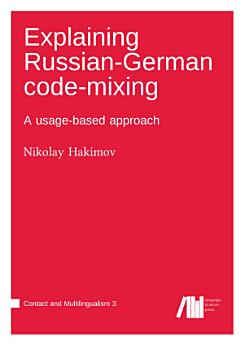Explaining Russian-German code-mixing
Nikolay Hakimov
Jan 2021 · Contact and Multilingualism Buku 3 · Language Science Press
eBook
306
Halaman
family_home
Memenuhi syarat
info
reportRating dan ulasan tidak diverifikasi Pelajari Lebih Lanjut
Tentang eBook ini
The study of grammatical variation in language mixing has been at the core of research into bilingual language practices. Although various motivations have been proposed in the literature to account for possible mixing patterns, some of them are either controversial, or remain untested. Little is still known about whether and how frequency of use of linguistic elements can contribute to the patterning of bilingual talk. This book is the first to systematically explore the factor usage frequency in a corpus of bilingual speech. The two aims are (i) to describe and analyze the variation in mixing patterns in the speech of Russia German adolescents and young adults in Germany, and (ii) to propose and test usage-based explanations of variation in mixing patterns in three morphosyntactic contexts: the adjective-modified noun phrase, the prepositional phrase, and the plural marking of German noun insertions in bilingual sentences. In these contexts, German noun insertions combine with either Russian or German words and grammatical markers, thus yielding mixed bilingual and German monolingual constituents in otherwise Russian sentences, the latter also labelled as embedded-language islands. The results suggest that the frequency with which words are used together mediates the distribution of mixing patterns in each of the examined contexts. The differing impacts of co-occurrence frequency are attributed to the distributional and semantic specifics of the analyzed morphosyntactic configurations. Lexical frequency has been found to be another important determinant in this variation. Other factors include recency, or lexical priming, in discourse in the case of prepositional phrases, and phonological and structural similarities and differences in the inflectional systems of the contact languages in the case of plural marking.
Tentang pengarang
Nikolay Hakimov is an assistant professor of Slavic Linguistics at the University of Bamberg. He completed his PhD at the University of Freiburg and subsequently worked at the University of Innsbruck. In his research, he focuses on social and cognitive aspects of linguistic variability and dynamicity. He is particularly interested in Slavic languages, multilingualism, spoken language, sound patterns of Slavic and their historical development. Among his recent publications is the special issue of The International Journal of Bilingualism dedicated to fused lects and their emergence (edited together with Peter Auer). He is currently working on a study exploring the prosodic features of the Old Novgorod dialect.
Beri rating eBook ini
Sampaikan pendapat Anda.
Informasi bacaan
Smartphone dan tablet
Instal aplikasi Google Play Buku untuk Android dan iPad/iPhone. Aplikasi akan disinkronkan secara otomatis dengan akun Anda dan dapat diakses secara online maupun offline di mana saja.
Laptop dan komputer
Anda dapat mendengarkan buku audio yang dibeli di Google Play menggunakan browser web komputer.
eReader dan perangkat lainnya
Untuk membaca di perangkat e-ink seperti Kobo eReaders, Anda perlu mendownload file dan mentransfernya ke perangkat Anda. Ikuti petunjuk Pusat bantuan yang mendetail untuk mentransfer file ke eReaders yang didukung.







